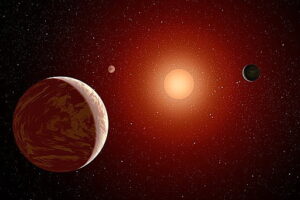
Overview
The question of extraterrestrial life on other worlds has baffled even the foremost scientists for millennia. With the Hubble telescope and now, the James Webb telescope floating in the cosmos a million miles from Earth, we are finding more and more life-sustaining planets on a frequent virtual basis.
This is different from space observatories being able to determine the existence of exoplanets by spectrum analysis, calculating their gravitational pull from their sun, or by use of the transit method – an observational process whereby a star changes in brightness when a planet is seen orbiting around it. The JWST advanced technology surpassed those methods by actually taking pictures of these exoplanets. This is the first time this has ever been done!
Exoplanets with Life? Maybe!
In 2013, a team of astronomers led by Dr. Duncan Wright from the University of New South Wales discovered the Wolf 1061 System, using the HARPS spectrograph, part of the European Southern Observatory’s telescope in La Salla in Chile.
This solar system contains an inactive red dwarf star, orbited by possibly seven planets including three super-Earths. These planets may be capable of supporting life as we know it, as they have a low enough mass to be potentially rocky with a solid surface.
The most interesting of the three planets is Wolf 1061c. At four times the size of the Earth, it is the closest habitable planet outside our solar system. It also sits in the Goldilocks Zone, close enough to its sun to contain liquid water and support life with its mild temperatures.

Even though rocky planets similar to our own and multi-planet systems are known to be abundant in our galaxy, most of the ones discovered are hundreds, if not thousands of light years away. They are too far for us to get to using current technology.
Still, with the hope of Wolf 1061c sitting right next door, scientists are now hopeful that they can test the planet’s atmosphere in more detail once it passes across the face of its star, making the not-so-lone Wolf planet easier to study and determine if it has the potential to sustain life.
Life is Out There

Here we list a sampling of just a few exoplanets that could sustain life.
WASP-39 b
In 2022, the James Webb Telescope discovered a planet, called WASP-39 b in the Virgo constellation. Known as ‘Bocaprins’, the planet orbits a star about 700 light-years from Earth. Scientists were surprised to see that this planet’s atomic structure resembles water and carbon – two of the essential ingredients of universal life.
Kepler-186f
But that’s not all. Planets such as Kepler-186f are one of the planets that astronomers say have a very good chance of potential life, relative to the hundreds of other planets discovered outside of our solar system. Kepler-186f is the first exoplanet found to be in the habitable zone. Slightly larger than Earth, it is 490 light-years away. That’s not too far comparatively speaking.
Kepler-22b
Another close neighbor in the habitable zone is Kepler-22b. This body is about 150 light-years further away than Kepler-186 but has the promise of life just the same. It is about 15% closer to its sun than our Earth is to our sun, but its sun is smaller than ours, so there is a compensation effect where these two factors cancel each other out.
Subsequently, it still provides the opportunity for the planet to remain in the habitable zone. Kepler-22b has a surface temperature of 72℉. This sounds like a good vacation spot when we get to that point of space travel. For Star Trek fans, you can envision the beautiful planets the crew visited when on shore leave. Well, not so fast.
Kepler-22b might be more on its axis than Earth, meaning half of the planet may have all sunlight 24×7 and the other half may be in complete darkness for every (of that) planet’s six months. Further study has revealed that the planet may be 90% ocean or more; thereby compensating for the seasonal issues.
Additionally, Kepler-22b has been calculated to have a much stronger gravitational pull than our planet, so walking on this planet may be as hard as trying to walk briskly through water at the same speed that you would be walking on land.
But if there are creatures on this planet, intelligent or not, natural evolution may cause these beings to look much different from us. Due to the planet’s strong gravitational pull, the aliens may have budging feet full of muscles that would make the strongest man in the world look like a stick figure. They may have more than just two or four legs. Additionally, their internal organs would have to be naturally engineered to handle the physical stresses of the planet’s strong gravity; such as an overly large heart.
The Day the Earth May Stand Still
If Kepler-22b is life sustainable, it would take astronauts 635 years to get there. So since that is out of the question for us, but if there is intelligent life there or on other planets, their technology might provide a quicker way to come here and visit us. But is that what we would want?
